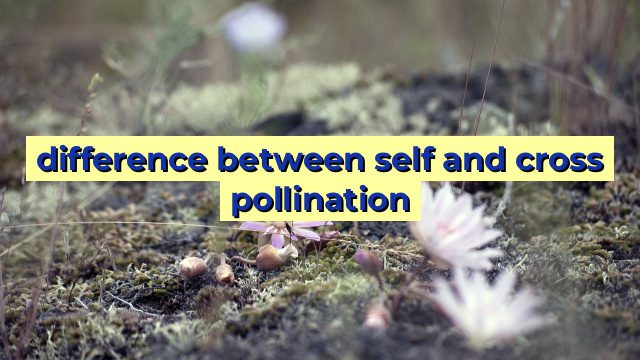Difference Between Self and Cross Pollination
Introduction
Pollination is the process by which pollen from the male part of a flower is transferred to the female part of another flower or onto the same flower to enable fertilization. Pollination is a natural phenomenon and essential for plant reproduction. Pollination can be carried out in two ways: self-pollination and cross-pollination. In this article, we will highlight the differences between self-pollination and cross-pollination.
Self-Pollination
Self-pollination is the transfer of pollen from the male part of a flower to the female part of the same flower. In other words, the same flower is both the male and the female. Self-pollination is a common phenomenon in some plant species. Self-pollination does not require external agents such as insects or wind to transfer pollen. The pollen simply falls from the anthers of the flower and lands on the stigma of the same flower, which enables fertilization. Self-pollination results in offspring that are genetically identical to the parent plant since it involves the transfer of pollen from the same plant.
Cross-Pollination
Cross-pollination is the transfer of pollen from the male part of one flower to the female part of another flower of a different plant of the same species. Cross-pollination requires agents such as wind or insects to carry the pollen from the male flower to the female flower. Cross-pollination results in offspring that are genetically different from the parent plant since it involves the transfer of pollen from a different plant.
Benefits and Disadvantages of Self-Pollination and Cross-Pollination
Self-pollination ensures that plants can reproduce even when there is a scarcity of pollinators or when pollinators are unable to reach the flowers because of unfavorable weather conditions. Self-pollination is also advantageous for plants that are growing in isolated areas where pollinators are scarce. However, self-pollination can lead to inbreeding depression, which is the reduced fitness of offspring that results from mating between genetically similar individuals.
Cross-pollination is advantageous because it results in genetically diverse offspring that are better adapted to their environment. Cross-pollination also prevents inbreeding depression and increases the population’s overall genetic diversity. However, cross-pollination requires the presence of pollinators such as insects, birds, and bats, which can be influenced by climate change, habitat loss, and pesticide use.
Conclusion
Pollination is an essential process that ensures plant reproduction. Self-pollination and cross-pollination are two methods by which plants can reproduce. Both methods have advantages and disadvantages, and the choice of pollination method depends on factors such as availability of pollinators, climate, habitat, and genetic diversity. Understanding the difference between self-pollination and cross-pollination can help farmers and scientists make informed decisions about plant breeding, conservation, and management.
Table difference between self and cross pollination
| Self-pollination | Cross-pollination |
|---|---|
| It occurs within the same flower or between flowers of the same plant. | It occurs between flowers of different plants or between flowers of the same plant with the help of an external agent like wind or insects. |
| It results in offspring that are genetically identical to the parent plant. | It results in offspring that have a mix of genetic traits from both parent plants. |
| It is a reliable method of reproduction but can limit genetic diversity. | It promotes genetic diversity but can be unreliable due to external factors such as wind or pollinator availability. |
| Examples include plants like peas and tomatoes. | Examples include plants like apples and cherries. |

